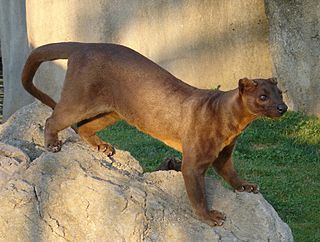
The fossa is a slender, long-tailed, cat-like mammal that is endemic to Madagascar. It is a member of the carnivoran family Eupleridae.

Grandidier's mongoose, also known as the giant-striped mongoose or Grandidier's vontsira, is a small carnivoran that lives only in a very small area of southwestern Madagascar, in areas of spiny forest vegetation. It is pale brown or grayish coloured, with eight wide, dark stripes on its back and sides. Grandidier's mongoose is larger than the related broad-striped Malagasy mongoose, G. fasciata, and its stripes are not as wide. The species is named after Alfred Grandidier.

The crowned lemur is a lemur that is 31–36 cm (12–14 in) long and weighs 2 kg (4.4 lb). Its tail is about 42–51 cm (17–20 in) long.
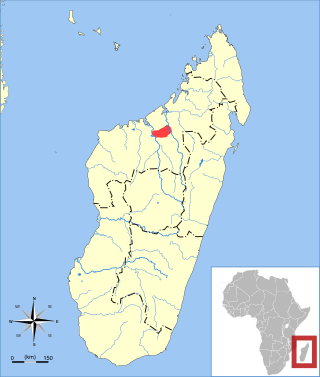
The greater big-footed mouse or long-tailed big-footed mouse is a nocturnal rodent found only in north west Madagascar. It was first described by F. Petter in 1959. It is listed as an endangered species as a result of habitat loss.

The eastern falanouc is a rare mongoose-like mammal in the carnivoran family Eupleridae endemic to Madagascar.
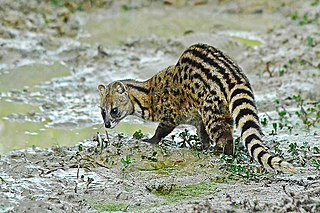
The small Indian civet is a civet native to South and Southeast Asia. It is listed as Least Concern on the IUCN Red List because of its widespread distribution, widespread habitat use and healthy populations living in agricultural and secondary landscapes of many range states.

The Madagascar dry deciduous forests represent a tropical dry forest ecoregion situated in the western and northern part of Madagascar. The area has high numbers of endemic plant and animal species but has suffered large-scale clearance for agriculture. They are among the world's richest and most distinctive dry forests and included in the Global 200 ecoregions by the World Wide Fund. The area is also home to distinctive limestone karst formations known as tsingy, including the World Heritage Site of Bemaraha.
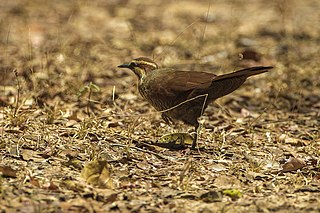
The white-breasted mesite is a ground-dwelling bird endemic to Madagascar. One of three species in the mesite family, Mesitornithidae, it is classified as vulnerable by the International Union for Conservation of Nature (IUCN). It has a small population and is restricted to five sites in the north and west of the island, and one in the east.

Makira Natural Park is a nature reserve in Madagascar's Northeastern region. In 2001, the Madagascar Ministry of Environment and Forests, in collaboration with the Wildlife Conservation Society (WCS), launched a program to create the 372,470 the Makira Forest Protected Area, with first temporary legal protections provided in 2005 as Makira Protected Area. Formally established as Makira Natural Park in 2012, the site is one of the largest of Madagascar’s protected areas and encompasses 372,470 hectares of strictly protected forest buffered by more than 350,000 hectares of community-managed forests. The Makira Natural Park is managed by WCS on behalf of the Government of Madagascar under a delegated management contract.

Eupleres is a genus of two species of mongoose-like euplerid mammal native to Madagascar that are known as falanoucs. They are primarily terrestrial and consume mainly invertebrates.

The Cozumel raccoon is a critically endangered species of island raccoon endemic on Cozumel Island off the coast of the Yucatan Peninsula, Mexico. It is sometimes also called the pygmy raccoon, dwarf raccoon, Cozumel Island raccoon, and Cozumel raccoon bear.

Coquerel's sifaka is a diurnal, medium-sized lemur of the sifaka genus Propithecus. It is native to northwest Madagascar. Coquerel's sifaka was once considered to be a subspecies of Verreaux's sifaka, but was eventually granted full species level, and is listed as Critically Endangered on the IUCN Red List due to habitat loss and hunting. In popular culture, it is known for being the species of the title character in the children's TV show Zoboomafoo. The species was named after French entomologist Charles Coquerel.

The narrow-striped mongoose or narrow-striped vontsira is a member of the family Eupleridae endemic to Madagascar. It inhabits the western Madagascar succulent woodlands and northern Madagascar spiny thickets in western and southwestern Madagascar, where it lives from sea level to about 125 m (410 ft) between the Tsiribihina and Mangoky rivers. In Malagasy it is called bokiboky. It is the only species in genus Mungotictis.

Cryptoprocta spelea, also known as the giant fossa, is an extinct species of carnivore from Madagascar in the family Eupleridae which is most closely related to the mongooses and includes all Malagasy carnivorans. It was first described in 1902, and in 1935 was recognized as a separate species from its closest relative, the living fossa. C. spelea was larger than the fossa, but otherwise similar. The two have not always been accepted as distinct species. When and how C. spelea became extinct is unknown; there is some anecdotal evidence, including reports of very large fossas, that there is more than one surviving species.

Zombitse-Vohibasia is a national park in the Atsimo-Andrefana region of south-west Madagascar. It is 147 kilometres (91 mi) north-east of the town of Toliara on the National road 7.

The crowned sifaka is a sifaka endemic to western Madagascar, a part of the world where nature and its biological diversity faces enormous and devastating consequences resulting from anthropogenic activities. It is a species of lemur belonging to the Idriidae family, it is of comparable size to the Golden-crowned sifaka and up to a meter in length, of which 47-57 centimeters are tail. The species is an arboreal vertical climber and leaper whose diet consists of leaves, fruits and flowers. It is threatened by habitat destruction caused by human activities and is currently classified as critically endangered by the IUCN. Conservation planning needs to take local people needs and views into account in order to be successful over the long term.
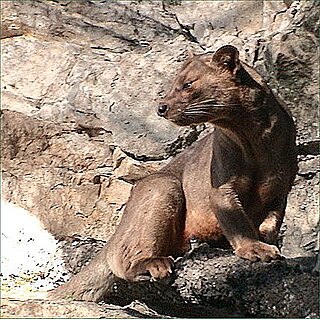
Euplerinae, more commonly known as malagasy civets, is a subfamily of carnivorans that includes four species restricted to Madagascar. Together with the subfamily Galidiinae, which also only occurs on Madagascar, it forms the family Eupleridae. Members of this subfamily, which include the fossa, falanoucs and Malagasy civet, were placed in families like Felidae and Viverridae before genetic data indicated their consanguinity with other Madagascar carnivorans. Within the subfamily, the falanouc and Malagasy civet are more closely related to each other than to the fossa.

The rhinoceros chameleon is a species of chameleon that gets its common name from its horn-like nose which is most prominent in males. It is endemic to dry forests in Madagascar.

Commerson's roundleaf bat, also known as Commerson's leaf-nosed bat, is a species of bat endemic to Madagascar. It is named after French naturalist Philibert Commerson (1727-1773). Bat populations of Africa or São Tomé and Príncipe formerly considered part of this species are now classified separately as M. gigas, M. thomensis or M. vittata, while one from Madagascar was split off to become M. cryptovalorona. It was formerly placed in the genus Hipposideros, but moved to the resurrected Macronycteris in 2017 on the basis of molecular evidence.

Mops jobimena, commonly known as the black and red free-tailed bat, is a species of bat in the family Molossidae. It is endemic to western Madagascar. With a forearm length of 45 to 48 mm,



















